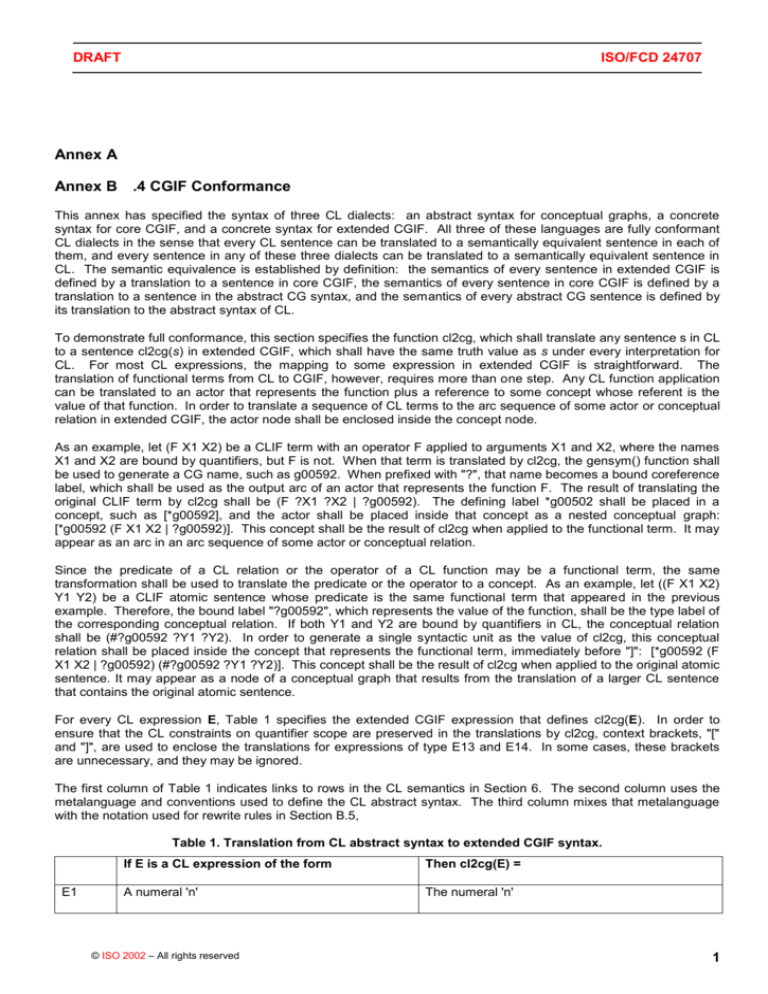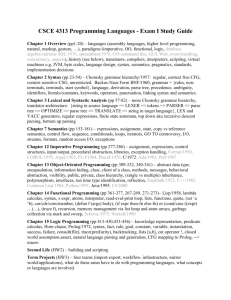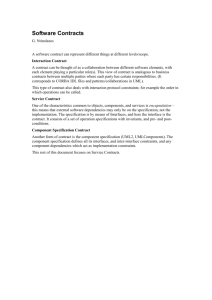
DRAFT
ISO/FCD 24707
Annex A
Annex B .4 CGIF Conformance
This annex has specified the syntax of three CL dialects: an abstract syntax for conceptual graphs, a concrete
syntax for core CGIF, and a concrete syntax for extended CGIF. All three of these languages are fully conformant
CL dialects in the sense that every CL sentence can be translated to a semantically equivalent sentence in each of
them, and every sentence in any of these three dialects can be translated to a semantically equivalent sentence in
CL. The semantic equivalence is established by definition: the semantics of every sentence in extended CGIF is
defined by a translation to a sentence in core CGIF, the semantics of every sentence in core CGIF is defined by a
translation to a sentence in the abstract CG syntax, and the semantics of every abstract CG sentence is defined by
its translation to the abstract syntax of CL.
To demonstrate full conformance, this section specifies the function cl2cg, which shall translate any sentence s in CL
to a sentence cl2cg(s) in extended CGIF, which shall have the same truth value as s under every interpretation for
CL. For most CL expressions, the mapping to some expression in extended CGIF is straightforward. The
translation of functional terms from CL to CGIF, however, requires more than one step. Any CL function application
can be translated to an actor that represents the function plus a reference to some concept whose referent is the
value of that function. In order to translate a sequence of CL terms to the arc sequence of some actor or conceptual
relation in extended CGIF, the actor node shall be enclosed inside the concept node.
As an example, let (F X1 X2) be a CLIF term with an operator F applied to arguments X1 and X2, where the names
X1 and X2 are bound by quantifiers, but F is not. When that term is translated by cl2cg, the gensym() function shall
be used to generate a CG name, such as g00592. When prefixed with "?", that name becomes a bound coreference
label, which shall be used as the output arc of an actor that represents the function F. The result of translating the
original CLIF term by cl2cg shall be (F ?X1 ?X2 | ?g00592). The defining label *g00502 shall be placed in a
concept, such as [*g00592], and the actor shall be placed inside that concept as a nested conceptual graph:
[*g00592 (F X1 X2 | ?g00592)]. This concept shall be the result of cl2cg when applied to the functional term. It may
appear as an arc in an arc sequence of some actor or conceptual relation.
Since the predicate of a CL relation or the operator of a CL function may be a functional term, the same
transformation shall be used to translate the predicate or the operator to a concept. As an example, let ((F X1 X2)
Y1 Y2) be a CLIF atomic sentence whose predicate is the same functional term that appeared in the previous
example. Therefore, the bound label "?g00592", which represents the value of the function, shall be the type label of
the corresponding conceptual relation. If both Y1 and Y2 are bound by quantifiers in CL, the conceptual relation
shall be (#?g00592 ?Y1 ?Y2). In order to generate a single syntactic unit as the value of cl2cg, this conceptual
relation shall be placed inside the concept that represents the functional term, immediately before "]": [*g00592 (F
X1 X2 | ?g00592) (#?g00592 ?Y1 ?Y2)]. This concept shall be the result of cl2cg when applied to the original atomic
sentence. It may appear as a node of a conceptual graph that results from the translation of a larger CL sentence
that contains the original atomic sentence.
For every CL expression E, Table 1 specifies the extended CGIF expression that defines cl2cg(E). In order to
ensure that the CL constraints on quantifier scope are preserved in the translations by cl2cg, context brackets, "["
and "]", are used to enclose the translations for expressions of type E13 and E14. In some cases, these brackets
are unnecessary, and they may be ignored.
The first column of Table 1 indicates links to rows in the CL semantics in Section 6. The second column uses the
metalanguage and conventions used to define the CL abstract syntax. The third column mixes that metalanguage
with the notation used for rewrite rules in Section B.5,
Table 1. Translation from CL abstract syntax to extended CGIF syntax.
E1
If E is a CL expression of the form
Then cl2cg(E) =
A numeral 'n'
The numeral 'n'
© ISO 2002 – All rights reserved
1
E1
A quoted string ‘s’
The quoted string 's'
E1
A interpretable name 'n'
The name 'n' shall be enclosed in quotes if it is not
a CG identifier. If it occurs in the quantifier of
some CL sentence, it shall be prefixed with "*". If
it is bound by a quantifier, it shall be prefixed with
"?".
E4
A term sequence T1 … Tn starting with a
sequence name T1
An arc sequence:
cl2cg(T1)
E3
A term sequence <T1 … Tn> starting with a term
T1
An arc sequence: cl2cg(T1, …, Tn)
E5
A term (O T1 … Tn)
A concept with a generated name 'n' that contains
a nested actor: "[", "*", 'n', "(", cl2cg(O), cl2cg(T1,
… Tn), ")", "|", "?", 'n', ")", "]"
A term (cl:comment ‘string’ T)
An arc with a comment: "/*", 'string', "*/", cg2cl(T)
An equation (= T1 T2)
A CG consisting of one, two, or three concepts.
E6
cl2cg(T2), ..., cl2cg(Tn),
If both T1 and T1 are names, one concept: "[:",
cl2cg(T1), cl2cg(T2), "]"
If both T1 and T2 are functional terms, three
concepts: cg2cl(T1), cg2cl(T2), "[", "?", 'n1', "?",
'n2', "]" where 'n1' is the name generated for T1
and 'n2' is the name generated for T2.
If Ti is a functional term (where i=1 or i=2) and the
other term Tj is a name, two concepts: cl2cg(Ti),
"[", "?", 'ni', cl2cg(Tj), "]" where 'ni' is the name
generated for Ti.
E7
An atomic sentence (P T1 … Tn)
A CG consisting of either a conceptual relation or
a concept.
If P is a name, a conceptual relation: "(", cl2cg(P),
cl2cg(T1), ..., (Tn), ")"
If P is a functional term, a
modified by inserting the
relation immediately before
cl2cg(T1), ..., cl2cg(Tn), ")"
generated for cl2cg(P).
2
concept: cl2cg(P) as
following conceptual
the closing "]": "(", 'n',
where 'n' is the name
E8
A boolean sentence (not P)
A negation: "~", "[", cl2cg(P), "]"
E9
A boolean sentence (and P1 … Pn)
A CG: cl2cg(P1), ..., cl2cg(Pn)
E10
A boolean sentence (or P1 … Pn)
A CG: "[", "Either", "[", "Or", cl2cg(P1), "]", ..., "[",
cl2cg(Pn), "]", "]"
E11
A boolean sentence (if P Q)
A CG: "[", "If", cl2cg(P), "[", "Then", cl2cg(Q), "]",
"]"
E12
A boolean sentence (iff P Q)
A CG: "[", "Equiv", ":", "[", "Iff", cl2cg(P), "]", "[",
cl2cg(Q), "]", "]"
A sentence (cl:comment ’string’ P)
A comment and a CG: "/*", 'string', "*/", cl2cg(P)
© ISO 2005– All rights reserved
E13
A quantified sentence (forall (N1 … Nn) B)
A CG: "[", "[", "@every", "*", cl2cg(N1), "]", ..., "[",
"@every", "*", cl2cg(Nn), "]", cl2cg(B), "]"
where N1 through Nn are names or sequence
names
E14
A quantified sentence (exists (N1 … Nn) B)
A CG: "[", "[", "*", cl2cg(N1), "]", ..., "[", "*",
cl2cg(Nn), "]", cl2cg(B), "]"
where N1 through Nn are names or sequence
names
A phrase (cl:comment “string”)
A comment: "/*", 'string', "*/"
E17
A phrase (cl:imports N)
A concept: "[", "cg_Imports", cl2cg(N), "]"
E19
A phrase (cl:text T1 … Tn )
A text: "[", "Text", cg2cl(T1 ... Tn), "]"
E20
(cl:text N T1 …Tn)
A text: "[", "Text", ":", cg2cl(N), cg2cl(T1 ... Tn), "]"
This completes the description of CGIF semantics for the purposes of this annex and conformance.
© ISO 2005 – All rights reserved
3









